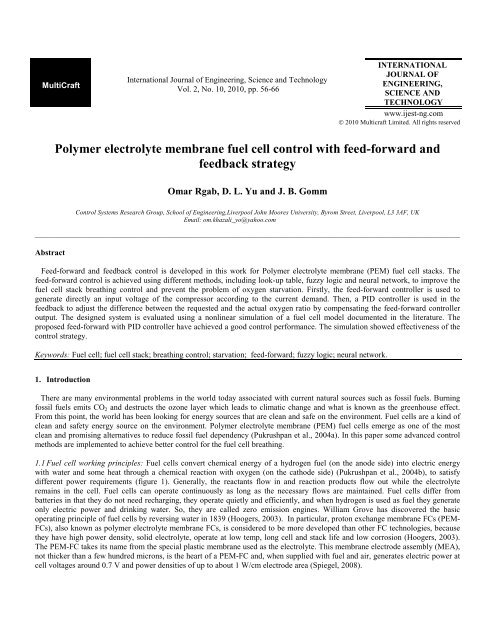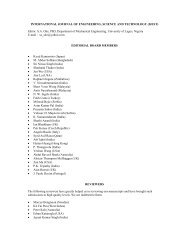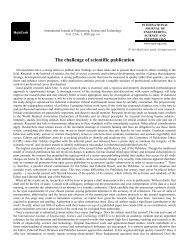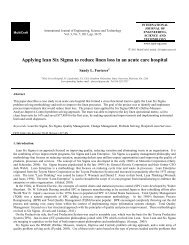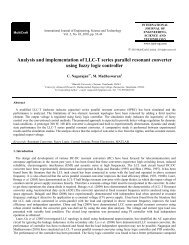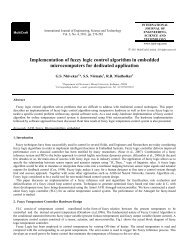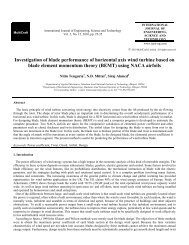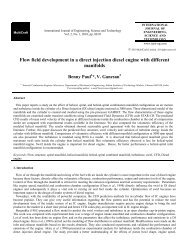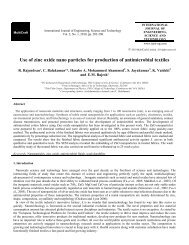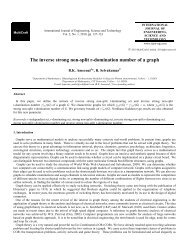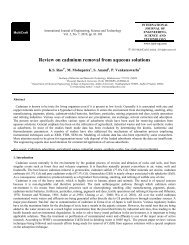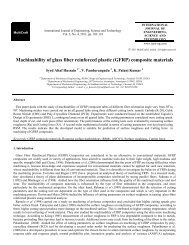Polymer electrolyte membrane fuel cell control with feed-forward ...
Polymer electrolyte membrane fuel cell control with feed-forward ...
Polymer electrolyte membrane fuel cell control with feed-forward ...
Create successful ePaper yourself
Turn your PDF publications into a flip-book with our unique Google optimized e-Paper software.
MultiCraft<br />
International Journal of Engineering, Science and Technology<br />
Vol. 2, No. 10, 2010, pp. 56-66<br />
INTERNATIONAL<br />
JOURNAL OF<br />
ENGINEERING,<br />
SCIENCE AND<br />
TECHNOLOGY<br />
www.ijest-ng.com<br />
© 2010 Multicraft Limited. All rights reserved<br />
<strong>Polymer</strong> <strong>electrolyte</strong> <strong>membrane</strong> <strong>fuel</strong> <strong>cell</strong> <strong>control</strong> <strong>with</strong> <strong>feed</strong>-<strong>forward</strong> and<br />
<strong>feed</strong>back strategy<br />
Omar Rgab, D. L. Yu and J. B. Gomm<br />
Control Systems Research Group, School of Engineering,Liverpool John Moores University, Byrom Street, Liverpool, L3 3AF, UK<br />
Email: om.khazali_yo@yahoo.com<br />
___________________________________________________________________________________________________________________________________<br />
Abstract<br />
Feed-<strong>forward</strong> and <strong>feed</strong>back <strong>control</strong> is developed in this work for <strong>Polymer</strong> <strong>electrolyte</strong> <strong>membrane</strong> (PEM) <strong>fuel</strong> <strong>cell</strong> stacks. The<br />
<strong>feed</strong>-<strong>forward</strong> <strong>control</strong> is achieved using different methods, including look-up table, fuzzy logic and neural network, to improve the<br />
<strong>fuel</strong> <strong>cell</strong> stack breathing <strong>control</strong> and prevent the problem of oxygen starvation. Firstly, the <strong>feed</strong>-<strong>forward</strong> <strong>control</strong>ler is used to<br />
generate directly an input voltage of the compressor according to the current demand. Then, a PID <strong>control</strong>ler is used in the<br />
<strong>feed</strong>back to adjust the difference between the requested and the actual oxygen ratio by compensating the <strong>feed</strong>-<strong>forward</strong> <strong>control</strong>ler<br />
output. The designed system is evaluated using a nonlinear simulation of a <strong>fuel</strong> <strong>cell</strong> model documented in the literature. The<br />
proposed <strong>feed</strong>-<strong>forward</strong> <strong>with</strong> PID <strong>control</strong>ler have achieved a good <strong>control</strong> performance. The simulation showed effectiveness of the<br />
<strong>control</strong> strategy.<br />
Keywords: Fuel <strong>cell</strong>; <strong>fuel</strong> <strong>cell</strong> stack; breathing <strong>control</strong>; starvation; <strong>feed</strong>-<strong>forward</strong>; fuzzy logic; neural network.<br />
1. Introduction<br />
There are many environmental problems in the world today associated <strong>with</strong> current natural sources such as fossil <strong>fuel</strong>s. Burning<br />
fossil <strong>fuel</strong>s emits CO 2 and destructs the ozone layer which leads to climatic change and what is known as the greenhouse effect.<br />
From this point, the world has been looking for energy sources that are clean and safe on the environment. Fuel <strong>cell</strong>s are a kind of<br />
clean and safety energy source on the environment. <strong>Polymer</strong> <strong>electrolyte</strong> <strong>membrane</strong> (PEM) <strong>fuel</strong> <strong>cell</strong>s emerge as one of the most<br />
clean and promising alternatives to reduce fossil <strong>fuel</strong> dependency (Pukrushpan et al., 2004a). In this paper some advanced <strong>control</strong><br />
methods are implemented to achieve better <strong>control</strong> for the <strong>fuel</strong> <strong>cell</strong> breathing.<br />
1.1 Fuel <strong>cell</strong> working principles: Fuel <strong>cell</strong>s convert chemical energy of a hydrogen <strong>fuel</strong> (on the anode side) into electric energy<br />
<strong>with</strong> water and some heat through a chemical reaction <strong>with</strong> oxygen (on the cathode side) (Pukrushpan et al., 2004b), to satisfy<br />
different power requirements (figure 1). Generally, the reactants flow in and reaction products flow out while the <strong>electrolyte</strong><br />
remains in the <strong>cell</strong>. Fuel <strong>cell</strong>s can operate continuously as long as the necessary flows are maintained. Fuel <strong>cell</strong>s differ from<br />
batteries in that they do not need recharging, they operate quietly and efficiently, and when hydrogen is used as <strong>fuel</strong> they generate<br />
only electric power and drinking water. So, they are called zero emission engines. William Grove has discovered the basic<br />
operating principle of <strong>fuel</strong> <strong>cell</strong>s by reversing water in 1839 (Hoogers, 2003). In particular, proton exchange <strong>membrane</strong> FCs (PEM-<br />
FCs), also known as polymer <strong>electrolyte</strong> <strong>membrane</strong> FCs, is considered to be more developed than other FC technologies, because<br />
they have high power density, solid <strong>electrolyte</strong>, operate at low temp, long <strong>cell</strong> and stack life and low corrosion (Hoogers, 2003).<br />
The PEM-FC takes its name from the special plastic <strong>membrane</strong> used as the <strong>electrolyte</strong>. This <strong>membrane</strong> electrode assembly (MEA),<br />
not thicker than a few hundred microns, is the heart of a PEM-FC and, when supplied <strong>with</strong> <strong>fuel</strong> and air, generates electric power at<br />
<strong>cell</strong> voltages around 0.7 V and power densities of up to about 1 W/cm electrode area (Spiegel, 2008).
57<br />
Rgab et al. / International Journal of Engineering, Science and Technology, Vol. 2, No. 10, 2010, pp. 56-66<br />
Exhaust<br />
Hydrogen<br />
Anode 2H2 4H + +4e -<br />
Water<br />
Membrane<br />
Air<br />
Compressor<br />
Catode O2+ 4H + +4e -<br />
2H2O<br />
Water<br />
Motor<br />
External Load<br />
Figure1. PME- FC reaction and structure<br />
Figure 2 shows a schematic of an MEA. The MEA is typically located between a pair of current collector plates (platinumimpregnated<br />
porous electrodes) <strong>with</strong> machined flow fields for distributing <strong>fuel</strong> and oxidant to the anode and cathode, respectively.<br />
A water jacket for cooling is often placed at the back of each reactant flow field followed by a metallic current collector plate. The<br />
<strong>cell</strong> can also contain a humidification section for the reactant gases, which are kept close to their saturation level in order to<br />
prevent dehydration of the <strong>membrane</strong> <strong>electrolyte</strong>. Many FCs are connected electrically in series to form an FC stack (FCS).<br />
V<br />
Electrical<br />
Load<br />
Ist<br />
Hydrogen<br />
Tank<br />
s<br />
Hydrogen in<br />
Fuel Cell Stack<br />
Oxygen in<br />
Motor<br />
Compressor<br />
Pump<br />
Humidifier<br />
Cooling system<br />
Pump<br />
Anode<br />
H + H + H +<br />
H + H +<br />
H +<br />
H +<br />
H +<br />
H + H +<br />
Catode<br />
Water out<br />
s<br />
Water Separator<br />
Filter<br />
λ<br />
O2<br />
Water Tank<br />
Figure 2. PEM <strong>fuel</strong> <strong>cell</strong> structure<br />
1.2 Fuel stack model: The <strong>fuel</strong> <strong>cell</strong> stack (FCS) model simulated in this paper consists of four interacting sub-models which are<br />
the stack voltage, the anode flow, the cathode flow, and the <strong>membrane</strong> hydration models (Pukrushpan et al., 2005). The voltage<br />
model contains an equation to calculate stack voltage that based on <strong>fuel</strong> <strong>cell</strong> temperature, pressure, reactant gas partial pressures<br />
and <strong>membrane</strong> humidity. In summary, the <strong>fuel</strong> <strong>cell</strong> voltage E is given by<br />
1<br />
E = 1.229 − 0.85 × 10<br />
−3<br />
( T 298.15) 4.3085 10<br />
5<br />
fc<br />
− + ×<br />
−<br />
T<br />
fc<br />
[ln( p ) + ( p )]<br />
(1)<br />
H 2 O2<br />
2<br />
Figure 3. Simulink model of integrated PEM <strong>fuel</strong> <strong>cell</strong>
58<br />
Rgab et al. / International Journal of Engineering, Science and Technology, Vol. 2, No. 10, 2010, pp. 56-66<br />
where, T fc the <strong>fuel</strong> <strong>cell</strong> temperature in Kelvin, p H2 and p O2 are the partial pressures of hydrogen and oxygen respectively, details<br />
in Pukrushpan et al. (2005, 2004c). In this model the stack temperature is assumed to be constant at 80 o C. The model which is used<br />
in our investigation is given in (Pukrushpan et al., 2005). The FCS Simulink model is created in Matlab 6.5.<br />
1.3 Literature survey: The main three parameters of <strong>fuel</strong> <strong>cell</strong> stack are stack current І st , stack voltage v st and the oxygen ratio λ o2 . A<br />
<strong>fuel</strong> <strong>cell</strong> (FC) stack has to be operated properly to get good power efficiency, reliability and smooth operation. The main<br />
disadvantage of the <strong>fuel</strong> <strong>cell</strong>s stack system is the oxygen starvation. Since current is instantaneously drawn from the load source<br />
connected to the FC, the FC <strong>control</strong> system is required to maintain optimal temperature, <strong>membrane</strong> hydration, and partial pressure<br />
of the reactants across the <strong>membrane</strong> to avoid detrimental degradation of the FC voltage, which can reduce efficiency. Fuel <strong>cell</strong><br />
parameters need to be <strong>control</strong>led to avoid the oxygen starvation phenomena when the current is drawn from the <strong>fuel</strong> <strong>cell</strong>. Some<br />
researchers have presented some methods to <strong>control</strong> the breathing of <strong>fuel</strong> <strong>cell</strong> stack in order to prevent the problem of oxygen<br />
starvation, and some other problems, which are now reviewed.<br />
Friede and Davat. (2004) proposed the governing equations of the transient behavior of a PEM <strong>fuel</strong> <strong>cell</strong> to show the influence of<br />
the operating conditions (such as temperature, pressure and gas flows have an effected on the humidity condition of the <strong>fuel</strong> <strong>cell</strong><br />
and their choice is the greatest challenge in <strong>fuel</strong> <strong>cell</strong> operation) and the current density on internal parameters, especially the ohmic<br />
resistance to improve the <strong>control</strong> of <strong>fuel</strong> <strong>cell</strong>. The models were suitable for description of highly nonlinear behavior of the <strong>fuel</strong><br />
<strong>cell</strong>s. Vahidi et al. (2006) have used a bank of ultra capacitors supplements the <strong>fuel</strong> <strong>cell</strong> during fast current transient in order to<br />
prevent <strong>fuel</strong> <strong>cell</strong> oxygen starvation, air compressor surge and choke, and simultaneously match an arbitrary level of current<br />
demand during rapid load demands. A model-predictive <strong>control</strong>ler has been designed for optimal distribution of current demand<br />
between the <strong>fuel</strong> <strong>cell</strong> and the bank of ultra capacitors, which is handled multiple constrains of the hybrid system. Pukrushpan et al.<br />
(2002) implemented a nonlinear <strong>fuel</strong> <strong>cell</strong> dynamic model for <strong>control</strong> study of <strong>fuel</strong> <strong>cell</strong>. The model has captured the transient<br />
phenomena which include the flow characteristics and inertia dynamics of the compressor, the manifold filling dynamics and<br />
consequently, the reactant partial pressures. They attempted to design an observer based <strong>feed</strong>back and <strong>feed</strong>-<strong>forward</strong> <strong>control</strong>ler that<br />
manages the tradeoff between reduction of parasitic losses and fast <strong>fuel</strong> <strong>cell</strong> net power response during rapid current (load)<br />
demands. An air flow <strong>control</strong>ler (Pukrushpan et al., 2004b) to protect the FC stack from oxygen starvation during step changes of<br />
current demand have been designed, the steady-state regulation of the oxygen excess ratio in the FCS cathode have been achieved<br />
by assigning an integrator to the compressor flow. Linear observablility techniques were employed to demonstrate improvements<br />
in transient oxygen regulation when the FCS voltage is included as a measurement for the <strong>feed</strong>back <strong>control</strong>ler. A linear optimal<br />
<strong>control</strong> design had been used to identify the frequencies (the FCS voltage signal contains high frequency information about the FC<br />
oxygen utilization, and thus, is a natural and valuable output for <strong>feed</strong>back) at which there was a severe tradeoff between the<br />
transient system net power performance and the stack starvation <strong>control</strong>. The limitation arises when the FCS system architecture<br />
dictates that all auxiliary equipment is powered directly from the FC <strong>with</strong> no secondary power sources. An observer was designed<br />
by Arcak et al. (2004) to estimate anode hydrogen pressure <strong>with</strong> an output injection term based on stack voltage. The paper by<br />
Kunusch et al. (2009) tackles the breathing problem of subsystem of a PEM <strong>fuel</strong> <strong>cell</strong> stacks by using a second order sliding mode<br />
strategy. The proposed <strong>control</strong> strategy is based on a super twisting algorithm that robustly solves the stabilization problem<br />
avoiding chattering effects. The resulting approach exhibits good dynamic characteristics, being robust to uncertainties and<br />
disturbances, and the results were provided showed the feasibility of the approach. A method for <strong>control</strong>ling a nonlinear underactuated<br />
system (DiFiore., 2009) using augmented sliding mode <strong>control</strong> (SMC) have been investigated, where the proposed <strong>control</strong><br />
approach involves introducing a transformation matrix mapping the systems input influence matrix to a transformed system that is<br />
square and thus invertible. The proposed approach is shown to <strong>control</strong> selectable states <strong>with</strong> proper choice of the transformation<br />
matrix yielding good <strong>control</strong> performance. From other hand, the methodology is applied to an under actuated nonlinear <strong>fuel</strong> <strong>cell</strong><br />
system to show its viability in a real world application, then a sliding mode <strong>control</strong>ler is derived for the full nonlinear system <strong>with</strong><br />
a switching gain accounting for modeling errors and uncertainties. Simulation results indicate the viability of the proposed <strong>control</strong><br />
law and demonstrate the robust nature of the <strong>control</strong> law in the presence of significant modeling errors while maintaining tracking<br />
stability. Finally, the augmented SMC is compared to a traditional linear <strong>control</strong> architecture illustrating the electiveness and<br />
advantages in tracking performance and <strong>control</strong> effort over traditional methods.<br />
2. Fuel <strong>cell</strong> <strong>control</strong> techniques<br />
The FC air flow needs to be <strong>control</strong>led rapidly and capably. In order to avoid oxygen starvation and extend the life of the FC<br />
stack (Yang et al.,1998) Oxygen starvation is a complicated phenomenon that occurs when the partial pressure of oxygen falls<br />
below a critical level at any location <strong>with</strong>in the meander of the air stream in the cathode (Springer et al., 2001). This phenomenon<br />
entails a rapid decrease in <strong>cell</strong> voltage, which in severe cases can causes a hot spot, or even burn-through on the surface of a<br />
<strong>membrane</strong>. Although the oxygen starvation is spatially varying, this phenomenon can be avoided by regulating the cathode excess<br />
oxygen ratio λ<br />
O2<br />
. We thus regulate air ratio in the FCS cathode by <strong>control</strong>ling compressor motor voltage V cm during step changes<br />
in current drawn I st from the FCS.<br />
2.1 Feed-Forward and Feedback <strong>control</strong> methods: The <strong>fuel</strong> <strong>cell</strong> model documented in (Pukrushpan et al., 2005) will be applied to<br />
the augmented <strong>feed</strong>-back (FB) and <strong>feed</strong>-<strong>forward</strong> (FF) <strong>control</strong>lers <strong>with</strong> different design methods for the FF <strong>control</strong>ler. Firstly the
59<br />
Rgab et al. / International Journal of Engineering, Science and Technology, Vol. 2, No. 10, 2010, pp. 56-66<br />
<strong>feed</strong>-<strong>forward</strong> FF <strong>control</strong>ler is used to generate directly an input voltage of the compressor according to the current demand. Then, a<br />
PID <strong>control</strong>ler is used in the <strong>feed</strong>back to adjust the difference between the requested and the actual oxygen ratio by compensating<br />
the <strong>feed</strong>-<strong>forward</strong> <strong>control</strong>ler output. The nonlinear state equations are x&<br />
NL<br />
= f ( xNL,<br />
u,<br />
d)<br />
, u=V (Control signal), d=I cm st<br />
(Disturbance inputs), where the <strong>control</strong> input u is the compressor motor voltage v , and the disturbance input d is the current I cm st<br />
drawn from the FCS. The performance variables are excess oxygen ratio y=λ O2 in the <strong>fuel</strong> <strong>cell</strong> cathode.<br />
2.2 System configuration: System configuration includes four different <strong>control</strong> schemes for the FC stack system <strong>with</strong> FF and FB<br />
<strong>control</strong>lers as shown in figure 4, the FF neural network method will be discussed later. The disturbance (stack current I st ) can be<br />
measured; FF <strong>control</strong>ler that correlates the steady state value between the <strong>control</strong> input v cm and the disturbance I st will be used in<br />
the FF path. The FF <strong>control</strong>ler will implement by different methods such as a look-up table, fuzzy logic <strong>control</strong>ler (5 and 9<br />
membership function MF) and neural network. Analytical modeling or experimental testing can be used to construct the inverse of<br />
compressor and compressor motor maps to find v & cm<br />
= f cm<br />
( I st<br />
) at desired oxygen flow w& cp<br />
. FF <strong>control</strong>ler and FB <strong>control</strong>ler can<br />
be designed to achieve better transient response. In fact, a FF <strong>control</strong>ler that cancels the effect of d to y over a wide range of<br />
frequencies is designed first. A <strong>feed</strong>back <strong>control</strong>ler (PID) is designed to reduce the error in the output of oxygen ratio λ O2 .<br />
2.3 Setting of PID <strong>control</strong>ler parameters: PID <strong>control</strong>ler equation given in (Ogata, 1997) has the following form:<br />
K<br />
Wc ( s)<br />
= K<br />
i p + + K<br />
d<br />
s<br />
(2)<br />
s<br />
Figure 4. Fuel <strong>cell</strong> <strong>control</strong> Construction. (a) Look-up table FF <strong>control</strong>ler and PID <strong>control</strong>ler (b) Fuzzy logic FF (5&9 MF.) and<br />
PID <strong>control</strong>ler. (c) Neural Network <strong>control</strong>ler FF and PID <strong>control</strong>ler.
60<br />
Rgab et al. / International Journal of Engineering, Science and Technology, Vol. 2, No. 10, 2010, pp. 56-66<br />
where, K p , K i and K d are proportional, integral and differential gains respectively. The PID is initially tuned by the Zigler and<br />
Nichols for the open loop method. The measured oxygen ratio is the Feedback signal of the system. After fine tuning, the PID<br />
<strong>control</strong>ler that is used here <strong>with</strong> Feed-<strong>forward</strong> <strong>control</strong>lers for oxygen ratio regulation is<br />
1<br />
W c( s)<br />
= 200 (1 + + 0.05s)<br />
(3)<br />
0.6153s<br />
Also, the best <strong>control</strong> results and corresponding <strong>fuel</strong> <strong>cell</strong> compressor voltages are shown in figures 9~12.<br />
2.4 Feed-<strong>forward</strong> <strong>control</strong>ler design<br />
2.4.1 Look-up table <strong>feed</strong>-<strong>forward</strong> <strong>control</strong>ler: The FF <strong>control</strong>ler here is implemented <strong>with</strong> a lookup table configuration, see figure<br />
4(a). The values of this table are obtained from the model by giving current values into the FCS model, and then we have used the<br />
compressor motor voltage V cm to regulate the oxygen excess ratio λ =2. Compressor voltage for each current value is illustrated<br />
O2<br />
in the table 1.<br />
Table 1. Compressor voltage (v cm ) and FCS current (I st ) values<br />
Current(I st ) Compressor voltage (v cm ) K= voltage /current<br />
100 100 1<br />
110 105.96 0.9633<br />
120 112 0.9333<br />
130 120.42 0.9263<br />
140 127 0.9071<br />
150 134.9 0.8993<br />
160 142 0.8875<br />
170 149 0.8764<br />
180 156 0.9166<br />
190 163 0.8579<br />
200 170 0.8500<br />
210 176.5 0.8404<br />
220 183.2 0.8327<br />
230 189.595 0.8240<br />
240 195.88 0.8162<br />
250 202 0.8080<br />
260 208 0.8000<br />
270 214.2 0.7933<br />
280 220.49 0.7875<br />
290 227 0.7828<br />
300 233.57 0.7786<br />
2.4.2 Feed-<strong>forward</strong> fuzzy logic <strong>control</strong>ler: The fuzzy logic <strong>control</strong> technique can be applied to <strong>control</strong> of the <strong>fuel</strong> <strong>cell</strong>, since the<br />
fuzzy logic is relatively simple and is based on definitions of formal facts and the relationships among them. In figure 4(b), the<br />
fuzzy <strong>control</strong>ler consists of the following main elements (Tsoukalas and Uhrig, 2000; Popovic and Bhatkar, 1997):<br />
• A set of <strong>control</strong> rules: IF (condition) Then (<strong>control</strong> actions), where "condition" defines the state of the process, for which<br />
the <strong>control</strong> adjustment specified in the <strong>control</strong> action should be executed. These rules are derived from the knowledge of<br />
experts <strong>with</strong> substantial experience in the system.<br />
• Membership functions MF: which are a simple yet versatile mathematical tool for indicating flexible memberships to a<br />
set, see figures (5a&5b). Fuzzy numbers are fuzzy subsets of the real line. They have a peak or plateau <strong>with</strong> membership<br />
grade 1, over which the members of the universe are completely in the set. The membership function is increasing<br />
towards the peak and decreasing away from it. Fuzzy membership functions are used in fuzzy <strong>control</strong> applications. A<br />
typical case is the triangular fuzzy membership function and is used in this studies (fig.5a &5b).<br />
• Fuzzification interface (the input of fuzzy <strong>control</strong>ler) is used to transform a crisp set into a fuzzy set or which transforms<br />
the <strong>control</strong> variables into fuzzy sets manipulated by a collection of fuzzy rules, assembled in what is known as the fuzzy<br />
inference engine (Tsoukalas and Uhrig, 2000). The fuzzy <strong>control</strong> has the following characteristics.
61<br />
Rgab et al. / International Journal of Engineering, Science and Technology, Vol. 2, No. 10, 2010, pp. 56-66<br />
Figure 5(a). Input variable “stack current” membership’s function<br />
Figure 5(b). Output variable “voltage” membership's function.<br />
2.4.2.1 Five membership fuzzy logic <strong>control</strong>ler: Fuzzy <strong>control</strong>ler is designed as case of process, where the inputs of fuzzy<br />
<strong>control</strong>ler is the <strong>fuel</strong> <strong>cell</strong> stack current "100~ 300A" (the current demand), and its output ∆output (the change of compressor<br />
voltage 100~235 volt, see table 1). The membership function for the input and output fuzzy logic <strong>control</strong>ler is divided to low, med<br />
low, normal, med high, high. From the table 1, we can write the rules, which should be applied for the mentioned above<br />
membership functions as the following way in table 2:<br />
R 1 -<br />
R 2 -<br />
R 3 -<br />
R 4 -<br />
R 5 -<br />
Table 2. Fuzzy logic <strong>control</strong>ler rules<br />
If current is low<br />
If current is med low<br />
If current is normal<br />
If current is med high<br />
If current is high<br />
then ∆voltage is low<br />
then ∆voltage is med low<br />
then ∆voltage is normal<br />
then ∆voltage is med high<br />
then ∆voltage is high<br />
Else<br />
Else<br />
Else<br />
Else<br />
Else<br />
2.4.2.2 Nine membership fuzzy logic <strong>control</strong>ler: In the same above principle in item 2.4.2.1, the fuzzy logic <strong>control</strong>ler <strong>with</strong> 9 MF is<br />
designed but the number MF and fuzzy logic will be different (9 MF and 9 rules). From figure 10, we can see clearly that there is a<br />
small over shoot at the first step when we used 5 MF fuzzy logic <strong>control</strong>ler <strong>with</strong> delay time at the sixth. However 9 MF fuzzy logic<br />
<strong>control</strong>ler recovered this problem as shown in figure 11.<br />
2.4.3 Neural network <strong>feed</strong>-<strong>forward</strong> <strong>control</strong>ler: Neural network technique can be applied in the <strong>control</strong>ling of the <strong>fuel</strong> <strong>cell</strong> stack<br />
system, see figure 4(c), since the <strong>control</strong> process is a multi-variable <strong>with</strong> non-linear behavior. The neural network here will be used<br />
to design the FF <strong>control</strong>ler because the neural net work can estimate the compressor voltage value which corresponding for any<br />
current demand value. The details of neural network structure are in (Tsoukalas and Uhrig, 2000; Haykin, 1999). The data, which<br />
is given in table 1, will be used to train the neural network. The neural network structure is illustrated in figure 6. The values of the<br />
<strong>fuel</strong> <strong>cell</strong> current (I st ) will be as an input to neural network model. In this case the input layer of neural network is one, see figure 6,<br />
and other parameters (voltage and k value) as an output signals. In this case the output layer has two outputs y 1 , y 2. The number of<br />
hidden layer nodes is chosen to be 9 bases on the test performed in this work. According to the test the network <strong>with</strong> 9 hidden layer<br />
nodes is a more appropriate one and gives very small absolute error between desired and calculated output (about 1.463×10 -9 ). The<br />
input and hidden layers is connecting by weights w1 i and its number is 9 as matrix (9×1). The hidden layer and outputs layer are<br />
connected by weights w2 ij its number is 18 (a matrix 2×9). Bias layers b1 j has value equal to 1 (Tsoukalas and Uhrig, 2000) are<br />
connected <strong>with</strong> the hidden layers by weights wb 1j as matrix 9×1. Also bias layers b 2i should be introduced, its value is equal to 1<br />
and connected to the output layers by weights wb 1i as matrix 2×1. In order to demonstrate supervised learning, the neural network<br />
includes the desired output vector O <strong>with</strong> the components O 1 ,O 2 the computed output vector Y <strong>with</strong> the component y 1 ,y 2 ,<br />
comparator, and weight-adjusting algorithm, this arrangement is shown in figure 6. In order to start the process, all weights in the<br />
neural network (figure 6) are randomly adjusted to small random value (-1~1) (Haykin., 1999). When the current values I st is
62<br />
Rgab et al. / International Journal of Engineering, Science and Technology, Vol. 2, No. 10, 2010, pp. 56-66<br />
applied to the neural net work, it produces an output vector Y, which is compared <strong>with</strong> the vector O by the comparator to produce<br />
the error vector e calculated by equation (4). The error is applied to weight-adjusting algorithm to adjust the weights.<br />
e = O − Y<br />
(4)<br />
The last process is repeated over and over until the error is reduced to some specified value or an irreducible small quantity. At<br />
that point the output vector Y and the desired output vector O are substantially equivalent, and the neural network is said to have<br />
been trained to map input vector I st into the desired output vector O The training procedure for the mentioned neural network<br />
(figure. 6) <strong>with</strong> the data of the <strong>fuel</strong> <strong>cell</strong> (table 1) as follows: the calculation is done by Matlap version 2009a according to the<br />
following equation:<br />
At first, the random values between (-1, 1) for the weights (w1 j , wb1 j , w2 ij , wb2 i ) to calculate the output Y j of neural net work<br />
(figure 6) are introduced.<br />
V = w1 ⋅ I + b1 × wb1<br />
, i = 1,......,9<br />
(5)<br />
i<br />
i<br />
st<br />
i<br />
i<br />
u<br />
i<br />
= Tanh( V ), i = 1,......,9<br />
i<br />
(6)<br />
where Vi is the summation part and u j is the activation part of hidden layers (Tsoukalas and Uhrig, 2000), where, w1j, the weights<br />
which connect between the input layers and the hidden layers. Its numbers are 9 as matrix (9×1), b 1j bias layers. Its number is 9<br />
and has values equal to 1, wb j , the weights which connect between the bias layers and hidden layers their numbers are 9 as matrix<br />
(9×1). The output y i is calculated from the following equation (Tsoukalas and Uhrig, 2000).<br />
9<br />
y<br />
j<br />
= ∑ ( u × w ) + b 2 × w b 2<br />
(7)<br />
i ij<br />
i<br />
i<br />
i = 1<br />
where; w ji is the weights which connect between the hidden layer and the output layer (Figure 6), and their numbers are 18 as<br />
matrix (2×9), b2 i Output bias layers, their numbers are 2 and have values equal to 1, wb2 i , the weights, which connect between the<br />
output bias layers b2 i and the output layers y j (figure 6) their numbers are 2 as matrix (2×1). The error ” e “ is calculated from<br />
the following equation:<br />
e = O - y<br />
(8)<br />
j<br />
j<br />
j<br />
O 2<br />
1 2<br />
Desired Output<br />
Pattern<br />
Error<br />
(e)<br />
O 1<br />
Comparator<br />
Weight Adjustment<br />
Algorithm<br />
bais layers<br />
i =1~2<br />
y 1<br />
y 2<br />
hidden layers<br />
1 2 3 4 5 6 7 8 9<br />
wb 1j<br />
b2i<br />
w 11<br />
wb 2i<br />
Actual output<br />
output layers<br />
input wegihts<br />
w ij<br />
w 92<br />
w 11 w 12<br />
w 13<br />
w 14 w 15<br />
w 16<br />
w 17 w 18<br />
w 19<br />
b1j<br />
bais layers<br />
j =1~9<br />
input wegihts w 1j<br />
1<br />
input<br />
layer<br />
Input data (Current<br />
values)<br />
Figure 6. Neural network Model <strong>with</strong> Supervised Learning.<br />
I st
63<br />
Rgab et al. / International Journal of Engineering, Science and Technology, Vol. 2, No. 10, 2010, pp. 56-66<br />
where O j , the output given in operational data or desired output, Y j , the output computed by the neural network, j = (1~ 2). The<br />
weights of the network are adjusted by applying back-propagation function to minimize the error. ∆ w ij (The change in the weights<br />
w ij ) is calculated from liner back-propagation function given in (Tsoukalas and Uhrig, 2000). The steps mentioned above are done<br />
for each current value (about 21 values), and repeated <strong>with</strong> changing the number of hidden layers and the type of activation<br />
function until we obtain the beast case (errors go to zero). The weights values which are corresponding to the zero error are<br />
recorded, and then the training for the neural network of figure 6 is completed and the output of NN can be calculated from<br />
equation (8), the Matlap version 2009a is used in our calculation.<br />
where, w is a matrix (2×9), u is (9×1) and b2×wb2 is matrix(2×1)<br />
y = w×<br />
u + b2×<br />
wb2<br />
(9)<br />
2.5 Simulations and Evaluation: Quality of <strong>control</strong>ling is defined by building up the output response of the <strong>fuel</strong> <strong>cell</strong> stack, and<br />
determines the values of Mean Absolute Error (MAE), where<br />
N<br />
N<br />
MAE =<br />
1 ∑ 2 − y(<br />
k)<br />
=<br />
1 ∑ e(<br />
k)<br />
. (10)<br />
N k=<br />
1<br />
N k=<br />
1<br />
The current demand changing depends on the type of the external electrical load. Usually the current in low demand is 100<br />
Ampere. The maximum current demand is about 300 Ampere. In our simulations, as shown in figure 7, a current demand changing<br />
gradually from 100 to 300 each 4 second. This almost covers the whole <strong>fuel</strong> <strong>cell</strong> stack operating condition.<br />
Figure 7. Current demand changing during <strong>control</strong>.<br />
The compressor voltage is to be <strong>control</strong>led between the 100 and 235 voltage and the oxygen ratio is to be <strong>control</strong>led between the<br />
-0.8% and +0.2% bounds of ideal value λ<br />
O2<br />
=2, i.e. 99.2%×2 ≤ O 2 ≤ 100.2%×2. The output response of the FCS by using the<br />
suggested <strong>control</strong> methods is compared <strong>with</strong> the output response of the traditional Proportional Feed-<strong>forward</strong> <strong>control</strong>ler (PFF <strong>with</strong><br />
k=164/191) as shown in figures 8, 9, 10, 11 and 12.<br />
Figure 8. Output Response of FCS <strong>with</strong> proportional and PID <strong>control</strong>lers at different stack current
64<br />
Rgab et al. / International Journal of Engineering, Science and Technology, Vol. 2, No. 10, 2010, pp. 56-66<br />
Figure 9. Output response of <strong>fuel</strong> <strong>cell</strong> <strong>control</strong> loop by using lookup table Feed-Forward Controller<br />
Figure 10. Output response of <strong>fuel</strong> <strong>cell</strong> <strong>control</strong> loop by using 5 MF. FL Feed-Forward <strong>control</strong>ler<br />
Figure 11. Output response <strong>fuel</strong> <strong>cell</strong> stack automatic <strong>control</strong> loop by using 9 MF. Fuzzy Logic <strong>control</strong>ler<br />
Figure 12. Output Response of FCS <strong>with</strong> neural network and PID <strong>control</strong>lers at different stack current<br />
So, from the figures we can see clearly that the Feed-<strong>forward</strong> neural network (FF-NN) has better performance than other<br />
<strong>control</strong>lers. The second performance is that using look-up table. Then, fuzzy logic <strong>with</strong> 9 MF followed by 5 MF and the last one is<br />
the PFF. However, the figure 8 shows a delay time at the first step about 4 sec in the output response of oxygen ratio when the<br />
Proportional Feed-<strong>forward</strong> Controller is used, in the second step there is about 2.5% overshoot as the same as 5 th step. In the same<br />
time the FF-NN, look-up table, 9 &5 MF <strong>control</strong>lers reduced this delay time and the overshoot as shown in figures 9, 10,11 and 12.
65<br />
Rgab et al. / International Journal of Engineering, Science and Technology, Vol. 2, No. 10, 2010, pp. 56-66<br />
Table 3, Evaluated Results<br />
Controller's type<br />
Mean Absolute Error(MAE)<br />
PID FB Controller P+ FF Controller 1.9468×10 -4<br />
PIDFB Controller+ Lookup table FF 4.8659×10 -5<br />
PIDFB Controller+ 5 MF. FL <strong>control</strong>ler 1.1893×10 -4<br />
PIDFB Controller +9MF. FL Controller 6.430×10 -5<br />
PIDFB Controller +NNFF Controller 6.2163×10 -6<br />
The results of simulation and evaluation by MAE are summarized in Table 3.<br />
3. Conclusion<br />
Based on the results summarized in Table 3, it is found that:<br />
• Neural Network FF <strong>control</strong>ler + FB <strong>control</strong>ler, they give better performance than other methods of <strong>control</strong>.<br />
• The difference between five and nine memberships function is about 0.00005463 of MAE and 9 MF is better than 5 MF,<br />
but of them are better than proportional Feed-<strong>forward</strong> <strong>control</strong>ler.<br />
• The mean absolute error of Look-up table FF <strong>control</strong>ler + FB <strong>control</strong>ler is 4.8659×10 -5 . So, we can say Lookup table is<br />
better performed than Proportional Feed-<strong>forward</strong> <strong>control</strong>ler.<br />
• The neural network FF <strong>control</strong>ler has better performance than other <strong>control</strong>lers because the neural network can estimate<br />
the corresponding compressor voltage for each current demand, it’s mean absolute error is =6.2163×10 -6 .<br />
Abbreviations<br />
PEM<br />
MEA<br />
FF<br />
PID<br />
FB<br />
FC<br />
PEMFC<br />
FCS<br />
MF<br />
NN<br />
MF FL<br />
FF-NN<br />
PFF<br />
<strong>Polymer</strong> <strong>electrolyte</strong> <strong>membrane</strong><br />
<strong>membrane</strong> electrode assembly<br />
Feed-<strong>forward</strong><br />
Proportional integral differential <strong>control</strong>ler<br />
Feed Back<br />
Fuel <strong>cell</strong><br />
<strong>Polymer</strong> <strong>electrolyte</strong> <strong>membrane</strong> <strong>fuel</strong> <strong>cell</strong><br />
Fuel <strong>cell</strong> stack<br />
Member ship function<br />
Neural net work<br />
Member ship fuzzy logic <strong>control</strong>ler<br />
Feed <strong>forward</strong> neural net work<br />
Proportional <strong>feed</strong> <strong>forward</strong><br />
References<br />
Arcak, M., Gorgun, H., Pedersen, L. M., Varigondab, S., 2004. A nonlinear observer design for <strong>fuel</strong> <strong>cell</strong> hydrogen estimation.<br />
IEEE Transactions on Control Systems Technology, Vol. 12, No. 1, pp. 101-110.<br />
DiFiore, D. C., 2009. Sliding mode <strong>control</strong> applied to an underactuated <strong>fuel</strong> <strong>cell</strong> system, Rochester Institute of Technology<br />
Rochester, New York.<br />
Friede, W., Davat, B., 2004. Mathematical model and characterization of the transient behavior of a PEM <strong>fuel</strong> <strong>cell</strong>. IEEE<br />
Transactions on Power Electronics, Vol. 19, No. 5, pp 1234-1241.<br />
Hoogers, G., 2003. Fuel Cell Technology Hand Book, Trier University of Applied Sciences, CRC Press LLC.<br />
Haykin Simon., 1999. Neural Network a Comprehensive Foundation., Second ed. Prentice-Hall. Inc. New Jersey.<br />
Kunusch, C., Puleston, P. F., Mayosky, M. A., Riera, J., 2009. Sliding mode strategy for PEM <strong>fuel</strong> <strong>cell</strong>s stacks breathing <strong>control</strong><br />
using a super-twisting algorithm, IEEE Transactions on Control Systems Technology, Vol. 17, No. 1, pp. 167-173.<br />
Vahidi, A., Stefanopoulou, A., Peng, H., 2006. Current management in a hybrid <strong>fuel</strong> <strong>cell</strong> power system: a model predictive <strong>control</strong><br />
approch, IEEE Transactions on Control Systems Technology, Vol. 14, No. 6, pp. 1047-1057.<br />
Ogata, K., 1997. Modern Control Engineering. Third ed. New Jersey.
66<br />
Rgab et al. / International Journal of Engineering, Science and Technology, Vol. 2, No. 10, 2010, pp. 56-66<br />
Pukrushpan, J. T., Stefanopoulou, A., Peng, H., 2004. Control of <strong>fuel</strong> <strong>cell</strong> power systems. Springer, Vol. 13, No. 1, pp 3-14.<br />
Pukrushpan, J. T., Stefanopoulou, A., Peng, H., 2002. Modeling and <strong>control</strong> for PEM <strong>fuel</strong> <strong>cell</strong> stack system. Proceedings of the<br />
American Control Conference Anchorage, AK, Vol. 5, pp. 3117-3122.<br />
Pukrushpan, J. T., Stefanopoulou, A., Peng, H., 2004a. Control of <strong>fuel</strong> <strong>cell</strong> breathing. IEEE Control Systems Magazine. Vol. 24,<br />
No. 2, pp. 30-46.<br />
Pukrushpan, J. T., Stefanopoulou, A., Peng, H., 2004b. Control of <strong>fuel</strong> <strong>cell</strong> power systems principles: modeling, analysis and<br />
<strong>feed</strong>back design, Springer-Verlag London Limited.<br />
Pukrushpan, J. T., Stefanopoulou, A., Peng, H., 2005. Control of natural gas catalytic partial oxidation for hydrogen generation in<br />
<strong>fuel</strong> <strong>cell</strong> applications, IEEE Transactions on Control Systems Technology, Vol. 13, No. 1, pp 3-14.<br />
Popovic, D., Bhatkar V. P., 1997. Distributed computer <strong>control</strong> for industrial automation. New York.<br />
Spiegel, C., 2008. PEM Fuel Cell modeling and simulation using Matlab, Academic Press is an imprint of Elsevier.<br />
Springer, T.E., R. Rockward, T.A. Zawodzinski, and S. Gottesfeld, 2001. Model for polymer <strong>electrolyte</strong> <strong>fuel</strong> <strong>cell</strong> operation on<br />
reformate <strong>feed</strong>, J. Electrochem. Soc., Vol. 148, No.1, PP. A11-A23.<br />
Yang, W. C., Bates, B., Fletcher, N., Pow, R., Control challenges and methodologies in <strong>fuel</strong> <strong>cell</strong> vehicle development, SAE<br />
international, Paper No. 98C054.<br />
Tsoukalas, H. L., Uhrig, E. R., 2000. Fuzzy and neural approaches in engineering. John Wiley- Interscience Publication, New<br />
York.<br />
Biographical notes<br />
Engineer Omar Ragb received B.Eng. degree in electrical engineering and automatic <strong>control</strong> from Bright Star University of Technology, Libya, in 1994, and<br />
M.sc. in automatic <strong>control</strong> engineering from Tabbin Institute for Metallurgical Studies, Egypt, in 2006. He was an Automatic Control and Instruments Engineer at<br />
Derna Cement Plant, Libya (1996-1998), he was as an Automatic Control and Instruments Engineer at Petroleum Golf Company, Libya (1998-1999), he was<br />
Electrical engineer at Al-Gabble Alakther dairy factory, Libya (2001), he was a Demonstrator in electrical engineering department at Omar Al-Mukhtar University,<br />
Libya ( 2002 -2003), he was a Lecturer assistant in Electrical Engineering Department at Omar Al-Mukhtar University Libya (2006- 2008), He is now a PhD<br />
student in school of engineering at Liverpool John Moores University (LJMU), UK, and His research interests include <strong>control</strong> systems research, Using a<br />
programmable logic <strong>control</strong>ler in automatic <strong>control</strong> system, Cement rotary kiln <strong>control</strong> research. His current research interests include advanced <strong>control</strong> systems for<br />
a <strong>fuel</strong> <strong>cell</strong> systems, adaptive neural networks and their <strong>control</strong> applications, model predictive <strong>control</strong> for <strong>fuel</strong> <strong>cell</strong> stack, in these areas he has published 2 conference<br />
papers and preparing 2 journals.<br />
Professor Dingli Yu received B.Eng from Harbin Civil Engineering College, China in 1982, M.Sc from Jilin University of Technology (JUT), China in 1986, and<br />
the PhD from Coventry University, U.K. in 1995, all in Control Engineering. Dr. Yu was a lecturer at JUT from 1986 to 1990, a visiting researcher at University of<br />
Salford, U.K. in 1991, a post-doctoral research fellow at Liverpool John Moores University (LJMU) from 1995 to 1998. He joined LJMU Engineering School in<br />
1998 as a Senior Lecturer and was promoted to a Reader in 2003, then to Professor of Control Systems in 2006. He is the associate editor of two journals,<br />
International Journal of Modelling Identification and Control and International Journal of Information & Systems Sciences. He organized two special issues in<br />
2006, “Fault Detection, Diagnosis and Fault Tolerant Control for Dynamic Systems” and “Intelligent Monitoring and Control for Industrial systems”. He serves as<br />
a member of the IFAC SAVEPROCESS Committee, and has been IPC member for many international conferences. He is a fellow of IET and Senior Member of<br />
IEEE. He leads the Control Systems Research group at LJMU. His current research interests include fault detection and fault tolerant <strong>control</strong> of bilinear and<br />
nonlinear systems, adaptive neural networks and their <strong>control</strong> applications, model predictive <strong>control</strong> for chemical processes and automotive engines and real-time<br />
evaluations, in these areas he has published more than 160 journal and conference papers.<br />
Dr. J. Barry Gomm received the B. Eng. first class degree in electrical and electronic engineering in 1987 and the Ph. D. degree in process fault detection in 1991<br />
from Liverpool John Moores University (LJMU), UK. He joined the academic staff at LJMU in 1991 and is a reader in intelligent <strong>control</strong> systems. His research<br />
interests include neural networks for modeling, <strong>control</strong> and fault diagnosis of non-linear processes, intelligent methods for <strong>control</strong>, system identification, adaptive<br />
systems, chemical process, and automotive applications.<br />
Received June 2010<br />
Accepted November 2010<br />
Final acceptance in revised form December 2010


